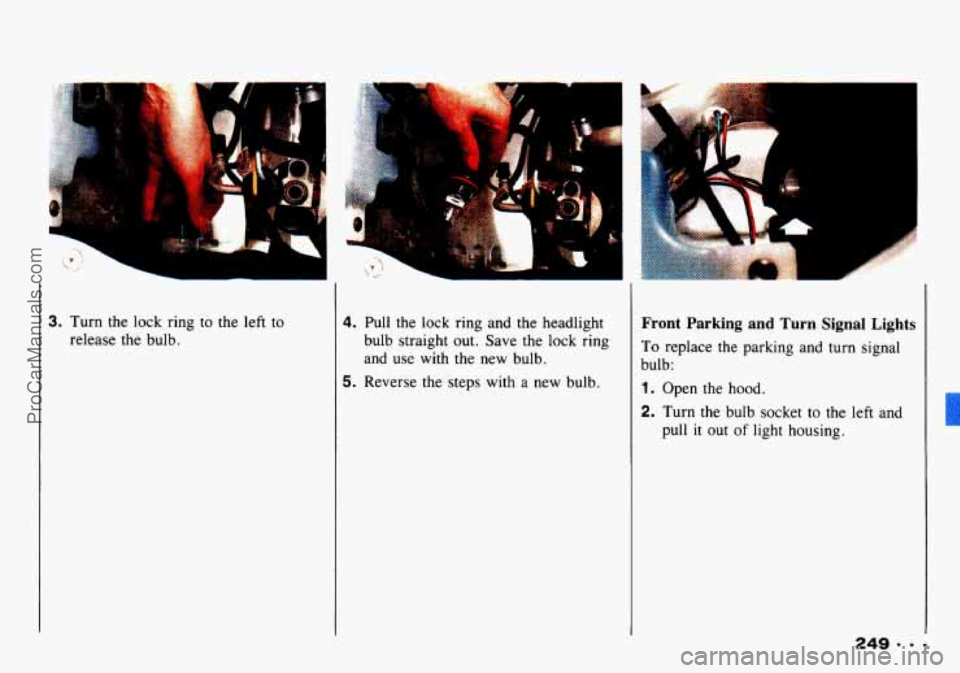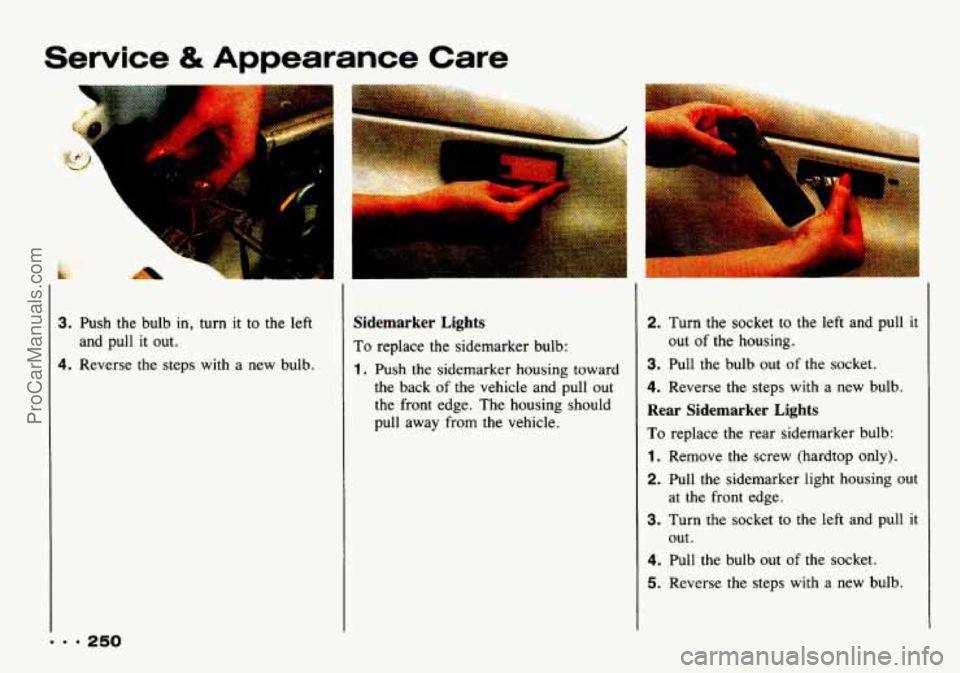1993 CHEVROLET TRACKER bulb
[x] Cancel search: bulbPage 70 of 339

Features & Controls
Turn Signal and lane Change
lndicator
The turn signal has two upward (for
Right) and two downward (for Left)
positions. These positions allow you to
signal a turn or a lane change.
To signal a turn, move the lever all the
way
up or down. When the turn is
finished, the lever will return
automatically.
A green arrow on the instrument panel
will flash in the direction of the turn or
lane change.
To signal a lane change, just raise or
lower the lever until the green arrow
starts to flash. Hold
it there until you
complete your lane change. The lever
will return by itself when you release it.
As you signal a turn or a lane change, if
the arrows don’t flash but just stay on, a
signal bulb may be burned out and other
drivers won’t see your turn signal. If
a bulb is burned out, replace it
to help
avoid an accident. If the green arrows
don’t go on at all when you signal a
turn, check the fuse (see “Fuses and
Circuit Breakers’’
in the Index) and for
burned-out bulbs.
ProCarManuals.com
Page 88 of 339

If you keep driving your vehicle
with this light on, after a while the
emission controls won’t work as
well, your fuel economy won’t be
as good and your engine may not
run as smoothly. This could lead
to costly repairs not covered by
your warranty.
-8.86
Engine Oil Pressure Light
If you have a problem with your oil,
this light may stay on after you start
your engine, or come on when you are
driving. This indicates that there is not
enough pressure to keep your engine
properly lubricated and cool. The engine
could be low on oil, or could have some
other oil related problem. Have it fixed
right away.
The oil light could also come on in three
other situations.
When the ignition is on but the engine
is not running, the light will come on
as a test to show you it is working,
but the light will
go out when you
turn the engine
to START. If it
doesn’t come on with the ignition on,
you may have a problem with the fuse
or bulb. Have it fixed right away.
Sometimes when the engine is idling
at a stop, the light may blink on and
off. This is normal.
may come on for a moment. This is
normal.
If you make a hard stop, the light
ProCarManuals.com
Page 185 of 339

Following Distance
Stay at least twice as far behind the
vehicle ahead as you would when
driving your vehicle without a trailer.
This can help you avoid situations that
require heavy braking and sudden turns.
Passing
You’ll need more passing distance up
ahead when you’re towing a trailer.
And, because you’re a good deal longer,
you’ll need to
go much farther beyond
the passed vehicle before you can return
to your lane.
Backing Up
Hold the bottom of the steering wheel
with one hand. Then, to move the trailer
to the left, just move that hand to the
left.
To move the trailer to the right,
move your hand to the right. Always
back up slowly and, if possible, have
someone guide you.
Making Turns
When you’re turning with a trailer,
make wider turns than normal.
Do this
so your trailer won’t strike soft
shoulders, curbs, road signs, trees, or
other objects. Avoid jerky
or sudden
maneuvers. Signal well in advance.
Turn Signals When Towing a Trailer
When you tow a trailer, your vehicle
has to have a different turn signal
flasher and extra wiring. The green
arrows on your instrument panel will
flash whenever you signal
a turn or lane
change. Properly hooked up, the trailer
lights will also flash telling other drivers
you’re about
to turn, change lanes, or
stop.
When towing a trailer, the green arrows
on your instrument panel will flash for
turns even if the bulbs on the trailer are
burned out. Thus, you may think drivers
behind you are seeing your signal when
ProCarManuals.com
Page 186 of 339

Your Driving and the Road
they are not. It’s important to check
occasionally to be sure the trailer bulbs
are still working.
Driving on Grades
Reduce speed and shift to a lower gear
before you start down a long or steep
downgrade. If you don’t shift down, you
might have to use your brakes
so much
that they would get hot and no longer
work well.
On a long uphill grade, shift down and
reduce your speed
to around 45 mph
(70 km/h) to reduce the possibility of
engine and transmission overheating.
If your trailer weighs more than 1,000
pounds
(450 kg), and you have a manual
transmission with fifth gear, it’s better
not to use fifth gear. Just drive
in fourth
gear (or, as you need to, a lower gear).
Parking on Hills
You really should not park your vehicle,
with a trailer attached, on a hill. If
something goes wrong, your rig could
start to move. People can be injured,
and both your vehicle and the trailer can
be damaged.
But
if you ever have to park your rig on
a hill, here’s how to do
it:
1. Apply your regular brakes, but don’t shift into
P (Park)
yet, or into gear
for a manual transmission.
the trailer wheels.
2. Have someone place chocks under
3. When the wheel chocks are in place,
release the regular brakes until the
chocks absorb the load.
apply your parking brake, and then
shift
to P (Park), or R (Reverse) for
a manual transmission.
vehicle, be sure the transfer case is
in a drive gear - not in N (Neutral).
4. Reapply the regular brakes. Then
5. If you have a four-wheel-drive
... 184
ProCarManuals.com
Page 223 of 339

Part 6
Here you wit1 find information
about the care of your Geo
. This
part begins with service and fuel
information. and then it shows
how to check important fluid and
lubricant levels
. There is also
technical information about your
vehicle. and
a section devoted to
its appearance care
.
ii iervice & Appearance Care
Service ............................................................. 222
Fuel ............................................................... 223
Checking Things under the Hood ........................................ 227 .
HoodRelease 227
Engineoil ........................................................ 229
Aircleaner ........................................................ 233
Automatic Transmission Fluid ........................................ 234
Manual Transmission Fluid ........................................... 237
Clutch Adjustment .................................................. 238
RearAxle ......................................................... 238
Four-WheelDrive .................................................. 239
Enginecoolant ..................................................... 240
Power Steering Fluid ................................................ 243
Windshield Washer Fluid ............................................ 244
Brake Master Cylinder ............................................... 245
Battery ........................................................... 247
Bulb Replacement .................................................... 248
LoadingYourVehicle ................................................. 252
Tires ............................................................... 253
Appearancecare ..................................................... 261
Appearance Care and Maintenance Materials .............................. 271
Vehicle Identification Number .......................................... 272
Service Parts Identification Label ........................................ 272
Add-on Electrical Equipment ........................................... 272
Fuses and Circuit Breakers ............................................. 273
ReplacementBulbs ................................................... 276
Capacities and Specifications ........................................... 277
221 .
.
......................................................
ProCarManuals.com
Page 250 of 339

Service & Appearance Care
I- ‘.-I
hdrm .
rn Bulb Replacement I LUU 1 lUIV
~ A Batteries have acid that can
burn you and gas that can
explode.
You can be badly hurt if
you aren’t careful. See
“Jump
Starting” in the Index for tips on
working around a battery without
getting hurt.
L
Contact your dealer to learn how to
prepare your vehicle for longer storage
periods. See “Replacement Bulbs” in the Index
to check
the size and type of bulb you
need to use.
Halogen Bulbs
Halogen bulbs have
pressurized gas inside and can
uurst
if you drop or scratch the
bulb.
You or others could be
injured. Take special care when
handling and disposing
of halogen
bulbs.
Headlights
To replace the headlight bulb:
1. Open the hood.
2. Press down on the tab and pull
rearward, while holding the headlight
wiring harness, to disconnect
it from
the bulb.
ProCarManuals.com
Page 251 of 339

3. Turn the lock ring to the left to
release the bulb.
4. Puli the lock ring and the headlight
bulb straight out. Save the lock ring
and use with the new bulb.
5. Reverse the steps with a new bulb.
Front Parking and Turn Signal Lights
To replace the parking and turn signal
bulb:
1 . Open the hood.
2. Turn the bulb socket to the left and I
pull it out of light housing.
ProCarManuals.com
Page 252 of 339

Service & Appearance Care
3. Push the bulb in, turn it to the left
4. Reverse the steps with a new bulb.
and
pull it out.
Sidemarker Lights
To replace
the sidemarker bulb:
1. Push the sidemarker housing toward
the back
of the vehicle and pull out
the front edge. The housing should
pull away from
the vehicle.
,
i
2. Turn the socket to the left and pull it
3. Pull the bulb out of the socket.
4. Reverse the steps with a new bulb.
Rear Sidemarker Lights
To replace the rear sidemarker bulb:
1. Remove the screw (hardtop only).
2. Pull the sidemarker light housing out
3. Turn the socket to the left and pull it
4. Pull the bulb out of the socket.
5. Reverse the steps with a new bulb.
out
of the
housing.
at the front edge.
out.
ProCarManuals.com